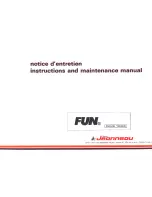
M
A I N T E N A N C E
A N D
S
E R V I C E
6–8
F
UEL
T
ANK
C
OMPARTMENT
The fuel tank compartments need to be rinsed periodically especially when used in a salt-
water environment. Dirt accumulation attracts salt, creating salt crystals. Salt crystals can corrode
most metal surfaces if left untreated over a period of time. To help protect your fuel tank from
corrosion, rinse the compartment with
fresh
water. After rinsing, make sure all water is drained
from the compartments. Remove the access plates from fuel tank lids and inspect this area for
leaks or unsecured lines.
The access plates on your fuel tank lids keep the fuel compartments sealed. Over time, the
opening and closing of these plates causes the o-rings to wear out. Replace these o-rings as
necessary to maintain the watertight integrity of the plates.
B
ATTERIES
Proper battery power is essential to the operation of your vessel. For this reason, Grady-White
has carefully chosen batteries with cranking ability and reserve capacity sufficient to meet your
needs. Grady-White uses Deka brand marine batteries, either the Master 27M6 or Intimidator
8A27M, depending on the boat model. If your boat is equipped with batteries not installed at the
factory, consult with the battery manufacturer for proper care and maintenance instructions and
the engine manufacturer for appropriate battery specifications. Replacements batteries should
always be of the same brand, model, age and size. Never mix different types of batteries.
The Marine Master 27M6 is a wet cell maintenance free battery that utilizes demineralized
electrolyte and calcium alloy grids. These features reduce water loss and extend the life of the
battery. However, this battery is maintenance accessible in the unlikely event a charging
malfunction occurs. Wet cell batteries must be secured in a non-metallic tray to contain electrolyte
spills.
The Intimidator 8A27M is an absorbed glass mat (AGM) battery that is completely spill proof
and maintenance free. AGM batteries recharge faster than conventional batteries and have a
higher tolerance to deep discharge for more severe applications. AGM batteries are subject to
permanent damage if used with a charging system not compatible with this technology, which
should be taken into consideration if using a charging system other than those installed on your
boat.
Batteries contain electrolytes and acids that can be harmful and volatile. They can also present
an electrical hazard. When handling or servicing batteries, exercise caution and follow these
guidelines.
• Avoid contact between skin, eyes, and clothing. Protective gloves and eye wear should be worn
when servicing to minimize risk.
• Batteries can produce explosive gases. Ventilate when charging. Keep sparks, flames and
cigarettes away at all times.
• An insulated boot should cover battery terminals in normal use. Never allow anything metal to
bridge between the positive and negative terminals which could arc or create a burn hazard.
• Keep battery terminals clean by scrubbing them with a stiff brush and a mixture of baking soda
and water. Afterwards, apply a light coat of grease or corrosion preventative.
• Batteries should be secured to minimize movement when the boat is in use.
Summary of Contents for Freedom 285
Page 2: ......
Page 10: ...W E L C O M E 1 4 ...
Page 18: ...S A F E T Y 2 8 ...
Page 26: ...G E N E R A L I N F O R M A T I O N 3 8 ...
Page 48: ...M A I N T E N A N C E A N D S E R V I C E 6 12 ...
















































